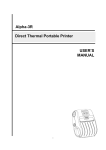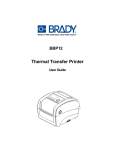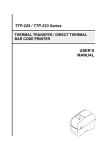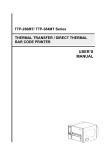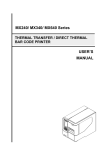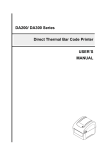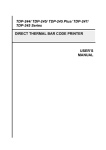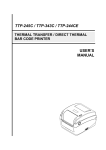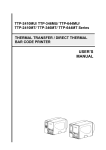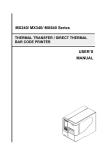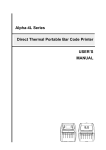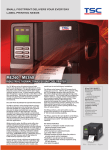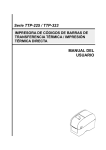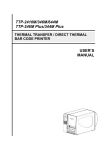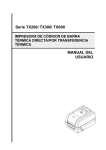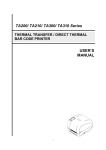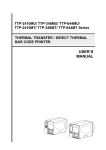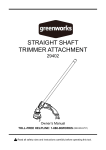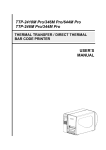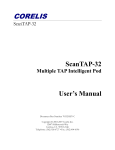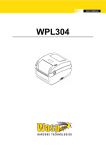Download USER`S MANUAL TC200/ TC210/ TC300/ TC310 Series
Transcript
TC200/ TC210/ TC300/ TC310 Series THERMAL TRANSFER / DIRECT THERMAL BAR CODE PRINTER USER’S MANUAL Copyright Information © 2015 TSC Auto ID Technology Co., Ltd. The copyright in this manual, the software and firmware in the printer described therein are owned by TSC Auto ID Technology Co., Ltd, All rights reserved. CG Triumvirate is a trademark of Agfa Corporation. CG Triumvirate Bold Condensed font is under license from the Monotype Corporation. Windows is a registered trademark of Microsoft Corporation. All other trademarks are the property of their respective owners. Information in this document is subject to change without notice and does not represent a commitment on the part of TSC Auto ID Technology Co. No part of this manual may be reproduced or transmitted in any form or by any means, for any purpose other than the purchaser’s personal use, without the expressed written permission of TSC Auto ID Technology Co. Agency Compliance and Approvals EN 55022, Class B EN 55024 EN 60950-1 FCC part 15B, Class B AS/NZS CISPR 22, Class B UL 60950-1(2nd Edition) CSA C22.2 No. 60950-1-07(2nd Edition) EN 60950-1 GB 4943.1 GB 9254 GB 17625.1 Wichtige Sicherheits-Hinweise 1. Bitte lesen Sie diese Hinweis sorgfältig durch. 2. Heben Sie diese Anleitung fűr den späteren Gebrauch auf. 3. Vor jedem Reinigen ist das Gerät vom Stromentz zu trennen. Verwenden Sie keine Flüssig-oder Aerosolreiniger. Am besten eignet sich ein angefeuchtetes Tuch zur Reinigung. 4. Die Netzanschluß -Steckdose soll nahe dem Gerät angebracht und leicht zugänglich sein. 5. Das Gerät ist vor Feuchtigkeit zu schűtzen. 6. Bei der Aufstellung des Gerätes ist auf sicheren Stand zu achten. Ein Kippen oder Fallen könnte Beschädigungen hervorrufen. 7. Beachten Sie beim Anschluß ans Stromnetz die Anschluß werte. 8. Dieses Gerät kann bis zu einer Auß entemperatur von maximal 40℃ betrieben werden. - ii - CAUTION 1. HAZARDOUS MOVING PARTS IN CUTTER MODULE. KEEP FINGER AND OTHER BODY PARTS AWAY. 2. THE MAIN BOARD INCLUDES REAL TIME CLOCK FEATURE HAS LITHIUM BATTERY CR2032 INSTALLED. RISK OF EXPLOSION IF BATTERY IS REPLACED BY AN INCORRECT TYPE. 3. DISPOSE OF USED BATTERIES ACCORDING TO THE MANUFACTURER INSTRUCTIONS. CAUTION Risk of explosion if battery is replaced by an incorrect type. Dispose of used batteries according to the instructions. “VORSICHT” Explosionsgefahr bei unsachgemäß en Austaush der Batterie. Ersatz nur durch denselben oder einem vom Hersteller empfohlenem ähnlichen Typ. Entsorgung gebrauchter Batterien nach Angabren des Herstellers. WARNUNG! GEFÄ HRLICHE BEWEGLICHE TEILE – FINGER UND ANDERE KÖ RPERTEILE FERNHALTEN! B 급기기 (가정용 정보통신기기) 이 기기는 가정용으로 전자파 적합등록을 한 기기로서 주거지역에서는 물론 모든 지역에서 사용할 수 있습니다. FCC STATEMENT : This equipment has been tested and found to comply with the limits for a Class B digital device, pursuant to part 15 of the FCC Rules. These limits are designed to provide reasonable protection against harmful interference in a residential installation. This equipment generates, uses and can radiate radio frequency energy and, if not installed and used in accordance with the instructions, may cause harmful interference to radio communications. However, there is no guarantee that interference will not occur in a particular installation. If this equipment does cause harmful interference to radio or television reception, which can be determined by turning the equipment off and on, the user is encouraged to try to correct the interference by one or more of the following measures: -Reorient or relocate the receiving antenna. -Increase the separation between the equipment and receiver. -Connect the equipment into an outlet on a circuit different from that to which the receiver is connected. - iii - -Consult the dealer or an experienced radio/ TV technician for help. This device complies with Part 15 of the FCC Rules. Operation is subject to the following two conditions: (1) This device may cause harmful interference, and (2) this device must accept any interference received, including interference that may cause undesired operation. This Class B digital apparatus complies with Canadian ICES-003 Cet appareil numérique de la classe B est conforme à la norme NMB-003 du Canada. Note: * Continuous printing will cause printer motor overheat. Printer will stop printing automatically about 10~15 minutes until motor is cooling down. Please don’t turn off power when printer pauses or the data transferred to printer buffer will be lost. * The maximum printing ratio per dot line is 15% for this printer. To print the full web black line, the maximum black line height is limited to 40 dots, which is 5mm for 203 DPI resolution printer and 3.3mm for 300 DPI resolution printers only, otherwise this may damage the power supply. - iv - Contents 1. Introduction ......................................................................................................................................... 1 1.1 Product Introduction ..................................................................................................................... 1 1.2 Product Features .......................................................................................................................... 2 1.2.1 Printer Standard Features ................................................................................................ 2 1.2.2 Printer Optional Features ................................................................................................. 4 1.3 General Specifications ................................................................................................................. 5 1.4 Print Specifications ..................................................................................................................... 5 1.5 Ribbon Specifications ................................................................................................................... 5 1.6 Media Specifications .................................................................................................................... 6 2. Operations Overview .......................................................................................................................... 7 2.1 Unpacking and Inspection ............................................................................................................ 7 2.2 Printer Overview ........................................................................................................................... 8 2.2.1 Front View .......................................................................................................................... 8 2.2.2 Interior view ..................................................................................................................... 10 2.2.3 Rear View ......................................................................................................................... 11 2.3 Operator Control ......................................................................................................................... 12 2.3.1 LED Indication ................................................................................................................. 12 2.3.2 Button Function .............................................................................................................. 12 3. Setup ................................................................................................................................................ 13 3.1 Setting up the printer .................................................................................................................. 13 3.2 Open/Close the Top Cover......................................................................................................... 14 3.3 Loading the Ribbon .................................................................................................................... 15 3.4 Loading the Media ...................................................................................................................... 18 3.4.1 Loading the Media........................................................................................................... 18 3.4.2 External Label Roll Mount Installation (Option) ........................................................... 21 3.4.3 Loading Media in Peel-off Mode (Option) ..................................................................... 23 3.4.4 Loading Media in Cutter Mode (Option)........................................................................ 25 4. Diagnostic Tool ................................................................................................................................. 26 4.1 Start the Diagnostic Tool ............................................................................................................ 26 4.2 Printer Function .......................................................................................................................... 27 4.3 Setting Ethernet by Diagnostic Tool ........................................................................................... 28 4.3.1 Using USB interface to setup Ethernet interface ......................................................... 28 4.3.2 Using RS-232 interface to setup Ethernet interface .................................................... 29 -v- 4.3.3 Using Ethernet interface to setup Ethernet interface.................................................. 30 5. Power-on Utilities.............................................................................................................................. 32 5.1 Ribbon and Gap/Black Mark Sensor Calibration........................................................................ 33 5.2 Gap/Black Mark Calibration, Self-test and Dump Mode ............................................................ 34 5.3 Printer Initialization ..................................................................................................................... 38 5.4 Set Black Mark Sensor as Media Sensor and Calibrate the Black Mark Sensor ....................... 39 5.5 Set Gap Sensor as Media Sensor and Calibrate the Gap Sensor ............................................. 40 5.6 Skip AUTO.BAS ......................................................................................................................... 41 6. LCD Menu Function ......................................................................................................................... 42 6.1 Enter the Menu ......................................................................................................................... 42 6.2 Main Menu Overview .................................................................................................................. 43 6.3 TSPL2......................................................................................................................................... 44 6.4 ZPL2 ......................................................................................................................................... 46 6.5 Sensor....................................................................................................................................... 49 6.6 Interface .................................................................................................................................... 50 6.6.1 Serial Comm. .................................................................................................................. 50 6.6.2 Ethernet ............................................................................................................................ 51 6.6.3 Bluetooth ......................................................................................................................... 52 6.6.4 Wi-Fi ................................................................................................................................. 52 6.7 File Manager ............................................................................................................................. 53 6.8 Diagnostics ............................................................................................................................... 54 6.8.1 Print Config. ................................................................................................................... 54 6.8.2 Dump Mode .................................................................................................................... 56 6.8.3 Print Head ....................................................................................................................... 57 6.8.4 Display ............................................................................................................................ 57 6.9 Advanced .................................................................................................................................. 58 6.10 Service ...................................................................................................................................... 59 7. Troubleshooting ................................................................................................................................ 60 8. Maintenance ..................................................................................................................................... 63 Revise History ....................................................................................................................................... 65 - vi - - vii - 1. Introduction 1.1 Product Introduction Thank you very much for purchasing TSC bar code printer. The TC200/210 series of thermal transfer desktop barcode printer, label printer with its new, smaller footprint, offers the high performance that customers have come to expect from TSC™. Durable, reliable and fast, the TC200/210 generates 4-inch-wide labels, tags or receipts at up to 6 ips, offering a price-performance combination that is unmatched by other desktop thermal barcode printers on the market. As with all TSC printers, the TC200/210 series features the TSPL-EZ™ printer-control language, which is fully compatible with other TSC printer languages, while supporting TPLE (Translation Printer Language Eltron® ) and TPLZ (Translation Printer Language Zebra® ). The languages automatically decipher and translate the format of each label as it is sent to the printer. TSPL-EZ™ also features internal scalable True Type fonts (based on the Monotype® font engine), which are typically found only in more expensive printers. Applications: Point-of-sale Product marking Receipt/ coupon printing Compliance labeling Asset tracking Document management Shipping/ receiving Inventory control Specimen labeling Patient tracking 1.2 Product Features 1.2.1 Printer Standard Features The printer offers the following standard features. TC200/TC300 model ○ TC210/TC310 model ○ 1 operating button and 1 LED with 3 colors ○ - 6 operating buttons and 1 LED with 3 colors - ○ 320 x 240 TFT LCD (UI of operating menu) - ○ 32-bit RISC high performance processor (Atmel 9260/ 210 MHz) 32-bit RISC high performance processor (Atmel 9G25/ 400 MHz) ○ - - ○ Center alignment holder with spiral spring ○ ○ Gap transmissive sensor (Fixed, center of offset 4 from center) ○ ○ Black mark reflective sensor (Position adjustable) ○ ○ Ribbon encoder sensor ○ ○ Head open sensor ○ ○ Automatic media/ribbon sensor selecting ○ ○ 4 MB Flash memory ○ - - ○ ○ - - ○ SD card reader for memory expansion, up to 4 GB ○ - SD card reader for memory expansion, up to 32 GB - ○ RS-232 interface (Max. 115,200 bps) ○ ○ USB 2.0 interface (Full speed mode) ○ - - ○ ○ ○ - ○ Parallel (SPP mode) ○ - Standard industry emulations right out of the box ® ® including Eltron and Zebra language support Internal 8 alpha-numeric bitmap fonts Fonts and bar codes can be printed in any one of the four directions (0, 90,180, 270 degree) ® Internal Monotype Imaging true type font engine with one CG Triumvirate Bold Condensed scalable font Downloadable fonts from PC to printer memory ○ ○ ○ ○ ○ ○ ○ ○ ○ ○ Unicode UTF8 support ○ ○ Product standard feature Thermal transfer/ or direct thermal 128 MB Flash memory 8 MB DRAM 64 MB DDR2 DRAM USB 2.0 interface (Hi speed mode) Internal Ethernet print server (10/100 Mbps) interface USB host -2- Bar code, graphics/image printing Supported bar code 1D bar code Code128 subsets A.B.C, Code128UCC, EAN128, Interleave 2 of 5, Code 39, Code 93, EAN13, EAN-8, Codabar, POSTNET, UPC-A, UPCE, EAN and UPC 2(5) digits, MSI, PLESSEY, China Post, ITF14, EAN14, Code 11, TELPEN, PLANET, Code 49, Deutsche Post Identcode, Deutsche Post Leitcode, LOGMARS 2D bar code CODABLOCK F mode, DataMatrix, Maxicode, PDF-417, Aztec, MicroPDF417, QR code, RSS Barcode (GS1 Databar) Supported image BITMAP, BMP, PCX (Max. 256 colors graphics) ○ ○ ○ ○ Supported code page: Codepage 437 (English - US) Codepage 737 (Greek) Codepage 850 (Latin-1) Codepage 852 (Latin-2) Codepage 855 (Cyrillic) Codepage 857 (Turkish) Codepage 860 (Portuguese) Codepage 861 (Icelandic) Codepage 862 (Hebrew) Codepage 863 (French Canadian) Codepage 864 (Arabic) Codepage 865 (Nordic) Codepage 866 (Russian) Codepage 869 (Greek 2) Codepage 950 (Traditional Chinese) Codepage 936 (Simplified Chinese) Codepage 932 (Japanese) Codepage 949 (Korean) Codepage 1250 (Latin-2) Codepage 1251 (Cyrillic) Codepage 1252 (Latin-1) Codepage 1253 (Greek) Codepage 1254 (Turkish) Codepage 1255 (Hebrew) Codepage 1256 (Arabic) Codepage 1257 (Baltic) Codepage 1258 (Vietnam) -3- ISO-8859-1: Latin-1 (Western European) ISO-8859-2: Latin-2 (Central European) ISO-8859-3: Latin-3 (South European) ISO-8859-4: Latin-4 (North European) ISO-8859-5: Cyrillic ISO-8859-6: Arabic ISO-8859-7: Greek ISO-8859-8: Hebrew ISO-8859-9: Turkish ISO-8859-10: Nordic ISO-8859-15: Latin-9 UTF-8 1.2.2 Printer Optional Features The printer offers the following optional features. User option Product option feature Dealer option Factory option Peel-off kit Paper length: 1” ~ 6” ○ Note: This peel-off module is supported for the thermal/ plain label only. Regular cutter (full cut guillotine cutter) Paper thickness: 0.06~ 0.19 mm Paper length: 1” ~ max. length Max. width: 110 mm ○ Note: Except for the linerless cutter, all regular/heavy duty/care label cutters DO NOT cut on media with glue. KP-200 Plus keyboard display unit ○ KU-007 Plus programmable smart keyboard ○ External roll mount with 3” core label spindle ○ Sleeve adapter ○ External Bluetooth module (serial interface) ○ External 802.11 b/g/n wireless module (serial interface) ○ Parallel port for TC210/TC310 series (replace USB host) ○ Real time clock & Buzzer ○ -4- 1.3 General Specifications General Specifications Physical dimensions Weight Mechanism Power Environmental condition Environmental concern 203 mm(W) x 191.5 mm(H) x 259.3 mm(D) TC200/TC300: 2.2 kg TC210/TC310: 2.3 kg Clamshell with Double-walled plastic External universal switching power supply • Input: AC 100-240V/ 2.5A, 50-60 Hz • Output: DC 24V/ 3.75A, 90W Operation: 5 ~ 40˚C (41 ~ 104˚F), 25~85% non-condensing Storage: -40 ~ 60 ˚C (-40 ~ 140˚F), 10~90% non-condensing Comply with RoHS, WEEE, REACH 1.4 Print Specifications Print Specifications TC200 Print head resolution (dots per inch/mm) 203 dots/inch (8 dots/mm) Printing method TC300 TC310 300 dots/inch (12 dots/mm) Thermal transfer/ or direct thermal Dot size (width x length) Print speed (inches per second) 0.125 x 0.125 mm (1 mm = 8 dots) 0.084 x 0.084 mm (1 mm = 12 dots) Up to 6 IPS Up to 4 IPS Max. 3 ips for peeler mode Max. print width Max. print length TC210 108 mm (4.25”) 2,286 mm (90”) Printout bias 105.6 mm (4.15”) 25,400 mm 1,016 mm (1000”) (40”) Vertical: 1 mm max. Horizontal: 1 mm max. 1.5 Ribbon Specifications Ribbon Specifications Ribbon outside diameter Max. 40 mm OD Ribbon length 110 meter Ribbon core inside diameter 0.5” ID core Ribbon width 40 mm ~110 mm Ribbon wound type Ink coated outside wound -5- 11,430 mm (450”) 1.6 Media Specifications Media Specifications Media roll capacity Max. 5” OD Media core diameter 1” & 1.5 ID core Media type Continuous, die-cut, black mark, external fan-fold, notch Media wound type Outside wound Media width 20 mm ~ 112 mm Media thickness 0.06 mm ~ 0.19 mm Label length 10 mm ~ max. print length Label length (peeler mode) 25.4 mm ~ 152.4 mm (1” ~ 6”) Label length (cutter mode) 25.4 ~ max. print length Black mark Min. 8 mm (W) x 2 mm (H) Gap height Min. 2 mm -6- 2. Operations Overview 2.1 Unpacking and Inspection This printer has been specially packaged to withstand damage during shipping. Please carefully inspect the packaging and printer upon receiving the bar code printer. Please retain the packaging materials in case you need to reship the printer. Unpacking the printer, the following items are included in the carton. One printer unit One Windows labeling software/Windows driver CD disk One quick installation guide One power cord One auto switching power supply One USB interface cable If any parts are missing, please contact the Customer Service Department of your purchased reseller or distributor. -7- 2.2 Printer Overview 2.2.1 Front View For TC210 series 1 4 2 5 6 3 7 7. P o w e r L E D display LCD i Menu n button d button Feed i LED c indicator a Navigation button t Ribbon access cover o r Top cover open lever 8. *SD card socket 9. Paper exit chute 1. 2. 3. 4. 5. 6. 8 9 For TC200 series 4 3 Pri nt he ad * Recommended SD card specification. For TC210 series SD card spec SD card capacity Approved SD card manufacturer V2.0 SDHC CLASS 4 2 GB Transcend V2.0 SDHC CLASS 4 8 GB SanDisk V3.0 CLASS 10 UHS 16 GB SanDisk V3.0 CLASS 10 UHS 32 MB Transcend V2.0 SDHC CLASS 4 microSD 4GB Transcend -8- P r i n t h e a d V2.0 SDHC CLASS 4 microSD 16 GB SanDisk V3.0 CLASS 10 UHS microSD 16GB Transcend, Kingston V3.0 CLASS 10 UHS microSD 32 GB SanDisk - The DOS FAT file system is supported for the SD card. - Folders/files stored in the SD card should be in the 8.3 filename format - The miniSD/microSD card to SD card slot adapter is required. For TC200 series SD card spec SD card capacity Approved SD card manufacturer V1.0, V1.1 128 MB SanDisk, Transcend V1.0, V1.1 256 MB SanDisk, Transcend, Panasonic V1.0, V1.1 512 MB SanDisk, Transcend, Panasonic V1.0, V1.1 1 GB SanDisk, Transcend, Panasonic V2.0 SDHC CLASS 4 4 GB V2.0 SDHC CLASS 6 4 GB SanDisk, Transcend, Panasonic V1.0, V1.1 microSD 128 MB Transcend, Panasonic V1.0, V1.1 microSD 256 MB Transcend, Panasonic V1.0, V1.1 microSD 512 MB Panasonic V1.0, V1.1 microSD 1 GB Transcend, Panasonic V2.0 SDHC CLASS 4 microSD 4 GB Panasonic V2.0 SDHC CLASS 6 microSD 4 GB Transcend V1.0, V1.1 miniSD 128 MB Transcend, Panasonic V1.0, V1.1 miniSD 256 MB Transcend, Panasonic V1.0, V1.1 miniSD 512 MB Transcend, Panasonic V1.0, V1.1 miniSD 1 GB Transcend, Panasonic V2.0 SDHC CLASS 4 miniSD 4 GB Transcend V2.0 SDHC CLASS 6 miniSD 4 GB - The DOS FAT file system is supported for the SD card. - Folders/files stored in the SD card should be in the 8.3 filename format - The miniSD/microSD card to SD card slot adapter is required. -9- 2.2.2 Interior view 1 7 2 P r8 i n 9t h Pri e nt a he d Pri ad nt he ad 3 P o w e r L E D i n d i c a 1. t 2. o r3. 4 10 11 Pri nt he ad Pri nt 12 he ad 5 13 6 Pri nt he ad Ribbon rewind hub Ribbon rewind gear Gap sensor (receiver) 4. Media holder 5. Media holder locking switch 6. Gap sensor (transmitter) 7. Print head 8. Ribbon supply hub 9. Top cover support 10. Media guide adjustment button 11. Media guides 12. Black mark sensor 13. Platen roller - 10 - Pri nt he ad 2.2.3 Rear View For TC210 series 7 1 2 1. Ethernet interface 2. USB interface 3. USB host 4 3 USB inter 6 face 5 US Pri For TC200 series B nt inte he rfa ad ce 4. RS-232C interface 5. Power jack socket 6. Power switch 1 2 8 4 5 7. External label entrance chute US Pri US B nt B inte he inte rfa ad rfa The interface picture here is for reference only. Please refer to the product ce ce specification for the interfaces availability. 8. Parallel interface - 11 - 6 2.3 Operator Control 2.3.1 LED Indication This printer has one three-color LED indicator. LED Color Description Green/ Solid This illuminates that the power is on and the device is ready to use. Green/ Flash This illuminates that the system is downloading data from PC to memory or the printer is paused. Amber This illuminates that the system is clearing data from printer. Red / Solid This illuminates printer head open, cutter error. Red / Flash This illuminates a printing error, such as head open, paper empty, paper jam, or memory error etc. 2.3.2 Button Function For TC200 series Feed button When the printer is ready, press the button to feed one label to the beginning of next label When the printer is printing, press the button to pause a print job. When the printer is paused the power LED will blink green. Press the button again to continue the printing job For TC210series Feed button When the printer is ready, press the button to feed one label to the beginning of next label When the printer is printing, press the button to pause a print job. When the printer is paused the power LED will blink green. Press the button again to continue the printing job When printer enter the menu, press the button to enter/select cursor located item Menu button Enter the menu Exit from a menu or cancel a setting and return to the previous menu Navigation button Scroll the menu list - 12 - 3. Setup 3.1 Setting up the printer 1. Place the printer on a flat, secure surface. 2. Make sure the power switch is off. 3. Connect the printer to the computer with the provided USB cable. 4. Plug the power cord into the AC power cord socket at the rear of the printer, and then plug the power cord into a properly grounded power outlet. Plug Power switch USB interface Power supply Note: Please switch OFF printer power switch prior to plug in the power cord to printer power jack. - 13 - 3.2 Open/Close the Top Cover 1. Open the printer’s top cover by pulling the top cover open levers located on each side of the printer and lifting the top cover to the maximum open angle. 2. A top cover support at the rear of the printer will engage with lower inner cover to hold the printer top cover open. 3. Hold the top cover and press the top cover support to disengage the top cover support with lower inner cover. Gently close the top cover. - 14 - 3.3 Loading the Ribbon 1. Open the printer’s top cover by pulling the top cover open levers located on each side of the printer and lifting the top cover to the maximum open angle. 2. Open the ribbon access cover and the media cover. Note: 1. In normal printing mode, ribbon access cover can be opened while opens the top cover. Ribbon access cover can be closed while top cover is open or close. 2. In peeler and cutter mode, please open the top cover then the ribbon access cover can be opened or closed. 3. Insert the ribbon right side onto the supply hub. Align the notches on the left side and mount onto the spokes. - 15 - 4. Insert the paper core right side onto the rewind hub. Align the notches on the left side and mount onto the spokes. 5. Stick the ribbon onto the ribbon rewind paper core. 6. Turn the ribbon rewind gear until the ribbon plastic leader is thoroughly wound and the black section of the ribbon covers the print head. - 16 - 7. Close the ribbon access cover and the top cover. Loading path for ribbon - 17 - 3.4 Loading the Media 3.4.1 Loading the Media 1. Open the printer top cover by pulling the tabs located on each side towards the front of the printer then lift the top cover to the maximum open angle. 2. Separate and hold open the media holders. 3. Place the roll between the holders and close them onto the core. - 18 - 4. Press down the media holder lock switch to hold the label roll firmly. 5. Place the paper, printing side face up, through the media sensor and place the label leading edge onto the platen roller. Move the media guides to fit the label width by turning the guide adjuster knob. 6. Disengage the top cover support and close the top cover gently. - 19 - 7. Use “Diagnostic Tool” or LCD menu function to set the media sensor type and calibrate the selected sensor. Note: Please calibrate the gap/black mark sensor when changing media. Please refer to the diagnostic utility quick start guide for more information. (Start the “Diagnostic tool” Select the “Printer Configuration” tab Click the “Calibrate Sensor” button ) Please refer to the section 6 for LCD menu function. Loading path for media - 20 - 3.4.2 External Label Roll Mount Installation (Option) 1. Attach an external paper roll mount on the bottom of the printer. 2. Insert a 3” label spindle into a paper roll. And install it on the external paper roll mount. 3. Open the printer’s top cover and separate the media holders to fit the media width. Press down the media holder lock switch to fix the media holder. PUSH - 21 - 4. Feeds the media through the rear external label entrance chute. And place the paper, printing side face up, through the media sensor and place the label leading edge onto the platen roller. Move the media guides to fit the label width by turning the guide adjuster knob. 5. Disengage the top cover support and close the top cover gently. 6. Use “Diagnostic Tool” or LCD menu function to set the media sensor type and calibrate the selected sensor. Note: Please calibrate the gap/black mark sensor when changing media. Please refer to the diagnostic utility quick start guide for more information. (Start the “Diagnostic tool” Select the “Printer Configuration” tab Click the “Calibrate Sensor” button ) Please refer to the section 6 for LCD menu function. - 22 - 3.4.3 Loading Media in Peel-off Mode (Option) 1. Please refer to section 3.3.1 to load the media. 2. Use “Diagnostic Tool” or LCD menu function to set the media sensor type and calibrate the selected sensor. Note: Please calibrate the gap/black mark sensor before loading media in peel-off mode to avoid paper jam. Please calibrate the gap/black mark sensor when changing media. 3. Open the printer cover. Pull the label through the front of the printer and take some labels off only leave the liner. 4. Open the peel-off module cover. Feed the liner into peel-off cover slot. 5. Close the peel-off module. Use the DiagTool or LCD menu function to enable the peel-off mode. - 23 - 6. Disengage the top cover support to close the top cover. Printer is ready for peel-off mode. 7. Press the FEED button to test. Note: This peel-off module is supported for the thermal/ plain label only. - 24 - 3.4.4 Loading Media in Cutter Mode (Option) 1. Please refer to section 3.3.1 to load the media. 2. Lead the media through the cutter paper opening. 3. Close the printer cover. 4. Use “Diagnostic Tool” or LCD menu function to set the media sensor type and calibrate the selected sensor. 5. Use the DiagTool or LCD menu function to enable the cutter mode. 6. Press the FEED button to test. Note: Please calibrate the gap/black mark sensor when changing media. - 25 - 4. Diagnostic Tool TSC’s Diagnostic Utility is an integrated tool incorporating features that enable you to explore a printer’s settings/status; change a printer’s settings; download graphics, fonts and firmware; create a printer bitmap font; and send additional commands to a printer. With the aid of this powerful tool, you can review printer status and setting in an instant, which makes it much easier to troubleshoot problems and other issues. 4.1 Start the Diagnostic Tool 1. Double click on the Diagnostic tool icon to start the software. 2. There are four features (Printer Configuration, File Manager, Bitmap Font Manager, Command Tool) included in the Diagnostic utility. Features tab Interface Printer functions Printer setup Printer Status - 26 - 4.2 Printer Function 1. Connect the printer and computer with a cable. 2. Select the PC interface connected with bar code printer. USB cable Other cable 2 1 The default interface setting is USB interface. If USB interface is connected with printer, no other settings need to be changed in the interface field. 3. Click the “Printer Function” button to setup. 4. The detail functions in the Printer Function Group are listed as below. Function Reset Printer Description Calibrate the sensor specified in the Printer Setup group media sensor field Setup the IP address, subnet mask, gateway for the on board Ethernet Synchronize printer Real Time Clock with PC Initialize the printer and restore the settings to factory default. Reboot printer Print Test Page Print a test page Configuration Page Print printer configuration Dump Text To activate the printer dump mode. Ignore AUTO.BAS Ignore the downloaded AUTO.BAS program Exit Line Mode Exit line mode. Password Setup Set the password to protect the settings Calibrate Sensor Ethernet Setup RTC Setup Factory Default Note: For more information about Diagnostic Tool, please refer to the diagnostic utility quick start guide in the CD disk \ Utilities directory. - 27 - 4.3 Setting Ethernet by Diagnostic Tool The Diagnostic Utility is enclosed in the CD disk \Utilities directory. Users can use Diagnostic Tool to setup the Ethernet by RS-232, USB and Ethernet interfaces. The following contents will instruct users how to configure the Ethernet by these three interfaces. 4.3.1 Using USB interface to setup Ethernet interface 1. Connect the printer and computer with USB cable. 2. Turn on the printer power switch. 3. Start the Diagnostic Utility by double clicking on the icon. 4. The Diagnostic Utility default interface setting is USB interface. If USB interface is connected with printer, no other settings need to be changed in the interface field. 5. Click on the “Ethernet Setup” button from “Printer Function” group in Printer Configuration tab to setup the IP address, subnet mask and gateway for the on board Ethernet. - 28 - 4.3.2 Using RS-232 interface to setup Ethernet interface 1. Connect the computer and the printer with a RS-232 cable. 2. Turn on the printer power. 3. Start the Diagnostic Utility by double clicks on the icon. 4. Select “COM” as interface then click on the “Setup” button to setup the serial port baud rate, parity check, data bits, stop bit and flow control parameters. 5. Click on the “Ethernet Setup” button from printer function of Printer Configuration tab to setup the IP address, subnet mask and the gateway for the on board Ethernet. - 29 - 4.3.3 Using Ethernet interface to setup Ethernet interface 1. Connect the computer and the printer to the LAN. 2. Turn on the printer power. 3. Start the Diagnostic Utility by double clicks on the icon. 4. Select “Ethernet” as the interface then click on the “Setup” button to setup the IP address, subnet mask and gateway for the on board Ethernet. 5. Click the “Discover Device” button to explore the printers that exist on the network. 6. Select the printer in the left side of listed printers, the correspondent IP address will be shown in the right side “IP address/Printer Name” field. 7. Click “Change IP Address” to configure the IP address obtained by DHCP or static. - 30 - The default IP address is obtained by DHCP. To change the setting to static IP address, click “Static IP” radio button then enter the IP address, subnet mask and gateway. Click “Set IP” to take effect the settings. Users can also change the “Printer Name” by another model name in this fields then click “Set Printer Name” to take effect this change. Note: After clicking the “Set Printer Name” or “Set IP” button, printer will reset to take effect the settings. 8. Click “Exit” button to exit the Ethernet interface setup and go back to Diagnostic Tool main screen. Factory Default button This function will reset the IP, subnet mask, gateway parameters obtained by DHCP and reset the printer name. Web setup button Except to use the Diagnostic Utility to setup the printer, you can also explore and configure the printer settings and status or update the firmware with the IE or Firefox web browser. This feature provides a user friendly setup interface and the capability to manage the printer remotely over a network. - 31 - 5. Power-on Utilities There are six power-on utilities to set up and test printer hardware. These utilities are activated by pressing FEED button then turning on the printer power simultaneously and release the button at different status of LED. Please follow the steps below for different power-on utilities. 1. Turn off the printer power switch. 2. Hold on the button then turn on the power switch. 3. Release the button when LED indicates with different status (color) for different functions. Power on utilities LED color The LED color will be changed as following pattern: Green Amber Red Amber Green Functions (5 blinks) (5 blinks) (5 blinks) Ribbon sensor calibration and gap / black mark sensor calibration Release Green/Amber Red/Amber (5 blinks) Solid green (5 blinks) Release Gap / black mark sensor calibration, Self-test and enter dump mode Release Printer initialization Release Set black mark sensor as media sensor and calibrate the black mark sensor Release Set gap sensor as media sensor and calibrate the gap sensor Release Skip AUTO.BAS - 32 - 5.1 Ribbon and Gap/Black Mark Sensor Calibration Gap/black mark sensor sensitivity should be calibrated at the following conditions: 1. A brand new printer 2. Change label stock 3. Printer initialization Please follow the steps below to calibrate the ribbon and gap/black mark sensor. 1. Turn off the power switch. 2. Hold on the button then turn on the power switch. 3. Release the button when LED becomes red and blinking. (Any red will do during the 5 blinks) It will calibrate the ribbon sensor and gap/black mark sensor sensitivity. The LED color will be changed as following order: Green amber red (5 blinks) amber (5 blinks) green (5 blinks) green/amber (5 blinks) red/amber (5 blinks) solid green Release button Note: Please select gap or black mark sensor by sending GAP or BLINE command to printer prior to calibrate the sensor. For more information about GAP and BLINE command, please refer to TSPL2 programming manual. - 33 - 5.2 Gap/Black Mark Calibration, Self-test and Dump Mode While calibrate the gap/black mark sensor, printer will measure the label length, print the internal configuration (self-test) on label and then enter the dump mode. To calibrate gap or black mark sensor, depends on the sensor setting in the last print job. Please follow the steps below to calibrate the sensor. 1. Turn off the power switch. 2. Hold on the button then turn on the power switch. 3. Release the button when LED becomes amber and blinking. (Any amber will do during the 5 blinks) The LED will be changed as following order. Green amber red (5 blinks) amber (5 blinks) green (5 blinks) green/amber (5 blinks) red/amber (5 blinks) solid green Release button 4. It calibrates the sensor and measures the label length and prints internal settings then enter the dump mode. Note: Please select gap or black mark sensor by Diagnostic Tool or by GAP or BLINE command prior to calibrate the sensor. For more information about GAP and BLINE command, please refer to TSPL2 programming manual. - 34 - Self-test Printer will print the printer configuration after gap/black mark sensor calibration. Self-test printout can be used to check if there is any dot damage on the heater element, printer configurations and available memory space. Self-test printout Model name F/W version Firmware checksum Printer S/N Configuration file System date System time Printed mileage (meter) Cutting counter Print speed (inch/sec) Print darkness Label size (inch) Gap distance (inch) Gap/black mark sensor intension Code page Country code ZPL setting information Print darkness Print speed (inch/sec) Label size Control prefix Format prefix Delimiter prefix Printer power up motion Printer head close motion Note: ® ZPL is emulating for Zebra language. RS232 serial port configuration - 35 - Numbers of download files Total & available memory space Print head check pattern - 36 - Dump mode Printer will enter dump mode after printing printer configuration. In the dump mode, all characters will be printed in 2 columns as following. The left side characters are received from your system and right side data are the corresponding hexadecimal value of the characters. It allows users or engineers to verify and debug the program. Hex decimal data related to left ASCII Data column of ASCII data Note: 1. Dump mode requires 4” wide paper width. 2. Turn off / on the power to resume printer for normal printing. - 37 - 5.3 Printer Initialization Printer initialization is used to clear DRAM and restore printer settings to defaults. The only one exception is ribbon sensitivity, which will note be restored to default. Printer initialization is activated by the following procedures. 1. Turn off the power switch. 2. Hold on the button then turn on the power switch. 3. Release the button when LED turns green after 5 amber blinks. (Any green will do during the 5 blinks) The LED will be changed as following: Green amber red (5 blinks) amber (5 blinks) green (5 blinks) green/amber (5 blinks) red/amber (5 blinks) solid green Release button Printer configuration will be restored to defaults as below after initialization. Parameter Speed Density Label Width Label Height Sensor Type Gap Setting Print Direction Reference Point Offset Tear Mode Peel off Mode Cutter Mode Serial Port Settings Code Page Country Code Clear Flash Memory IP Address Default setting 127 mm/sec (5 ips) (203DPI) 76 mm/sec (3 ips) (300DPI) 8 4” (101.5 mm) 4” (101.5 mm) Gap sensor 0.12” (3.0 mm) 0 0,0 (upper left corner) 0 On Off Off 9600 bps, none parity, 8 data bits, 1 stop bit 850 001 No DHCP - 38 - 5.4 Set Black Mark Sensor as Media Sensor and Calibrate the Black Mark Sensor Please follow the steps as below. 1. Turn off the power switch. 2. Hold on the button then turn on the power switch. 3. Release the button when LED turns green/amber after 5 green blinks. (Any green/amber will do during the 5 blinks). The LED will be changed as following: Green amber red (5 blinks) amber (5 blinks) green (5 blinks) green/amber (5 blinks) red/amber (5 blinks) solid green Release button - 39 - 5.5 Set Gap Sensor as Media Sensor and Calibrate the Gap Sensor Please follow the steps as below. 1. Turn off the power switch. 2. Hold on the button then turn on the power switch. 3. Release the button when LED turns red/amber after 5 green/amber blinks. (Any red/amber will do during the 5 blinks). The LED will be changed as following: Green amber red (5 blinks) amber (5 blinks) green (5 blinks) green/amber (5 blinks) red/amber (5 blinks) solid green Release button - 40 - 5.6 Skip AUTO.BAS TSPL2 programming language allows user to download an auto execution file to flash memory. Printer will run the AUTO.BAS program immediately when turning on printer power. The AUTO.BAS program can be interrupted without running the program by the power-on utility. Please follow the procedures below to skip an AUTO.BAS program. 1. Turn off printer power. 2. Press the FEED button and then turn on power. 3. Release the FEED button when LED becomes solid green. The LED will be changed as following: Green amber red (5 blinks) amber (5 blinks) green (5 blinks) green/amber (5 blinks) red/amber (5 blinks) solid green Release button 4. Printer will be interrupted to run the AUTO.BAS program. - 41 - 6. LCD Menu Function 6.1 Enter the Menu Press the “Menu” button to enter the main menu. Use the “Cross” button to select the item on main menu. The selected item will turn red. Press the “Feed” button to enter the setting list. Note: This LCD function is for TC210/310 series. - 42 - 6.2 Main Menu Overview There are 8 categories for the main menu. You can easy to set the settings of printer without connecting the computer. Please refer to following sections for more details. Menu TSPL ZPL2 Sensor Interface File Manager Diagnostics Advanced Service Speed Darkness Auto Calibration Serial Comm. DEAM Print Config. Display Brightness Initialization Density Print Speed Manual Setup Ethernet FLASH Dump Mode Date & Time Printer Information Direction Tear Off Threshold Detect Bluetooth (option) CARD Print haed Language Print Mode Print Mode Maximum Length Wi-Fi (option) Offset Print Width Advanced Shift X List Fonts Shift Y List Images Reference X List Formats Reference Y List Setup Code Page Control Prefix Country Format Prefix Display Sensor Delimiter Char Media Power Up Head Close Label Top Left Position Reprint Mode Format Convert - 43 - Contact us 6.3 TSPL2 This “TSPL2” category can set up the printer settings for TSPL2. Speed Menu TSPL Density None Direction Batch Mode Print mode Peeler Mode Offset Cutter Mode Shift X Cutter Batch Shift Y Reference X Reference Y Code Page Country Item Description Default Speed Use this item to setup print speed. Density Use this option to setup printing darkness. The available setting is from 0 to 15, and the step is 1. You may need to adjust your density based on selected media. N/A 8 The direction setting value is either 1 or 0. Use this item to setup the printout direction. DIRECTION 0 DIRECTION 1 FEED Direction 0 This item is used to set the print mode. There are 5 modes as below, Printer Mode Print mode None Batch Mode Description Next label top of form is aligned to the print head burn line location. (Tear Off Mode) Once image is printed completely, label gap/black mark will be fed to the tear plate location for tear away. - 44 - Batch Mode Peeler Mode Cutter Mode Cutter Batch Enable the label peel off mode. Enable the label cutter mode. Cut the label once at the end of the printing job. This item is used to fine tune media stop location. Available setting value is from “+” to “-” or “0” to “9”. Offset Shift X Shift Y Reference X Reference Y Code page Country This item is used to fine tune print position. Available setting value is from “+” to “-” or “0” to “9”. This item is used to set the origin of printer coordinate system horizontally and vertically. Available setting value is from “0” to “9”. Use this item to set the code page of international character set. Use this option to set the country code. Note: If printing from enclosed software/driver, the software/driver will send out the commands, which will overwrite the settings set from the panel. - 45 - +000 +000 +000 000 000 850 001 6.4 ZPL2 This “ZPL2” category can set up the printer settings for ZPL2. Darkness Print Speed Tear Off Tear Off Print Mode Peeler Off Print Width Cutter List Fonts List Images List Formats List Setup Control Prefix Format Prefix Feed Menu ZPL2 Delimiter Char Calibration Media Power Up Length No Motion Feed Calibration Head Close Label Top Length No Motion Left Position Enabled Reprint Mode Disabled None 150 -> 300 Format Convert 150 -> 600 200 -> 600 300 -> 600 Item Description Default Darkness Use this item to setup printing darkness. The available setting is from 0 to 30, and the step is 1. You may need to adjust your density based on selected media. - 46 - 16 Print Speed Use this item to setup print speed. The each increase or decrease is 1 ips. Available setting is from 2 to 6. Tear Off This item is used to fine tune media stop location. Available setting value is from “+” to “-” or “0” to “9”. 6 (203dpi) 4 (300dpi) 3 (600dpi) +000 This item is used to set the print mode. There are 3 modes as below, Print mode Printer Mode Tear Off Peeler Off Cutter Print Width List Fonts List Images List Formats List Setup Control Prefix Format Prefix Delimiter Char Description Next label top of form is aligned to the print head burn line location. Enable the label peel off mode. Enable the label cutter mode This item is used to set print width. The available value is from “0” to “9”. This feature is used to print current printer available fonts list to the label. The fonts stored in the printer’s DRAM, Flash or optional memory card. This feature is used to print current printer available images list to the label. The images stored in the printer’s DRAM, Flash or optional memory card. This feature is used to print current printer available formats list to the label. The formats stored in the printer’s DRAM, Flash or optional memory card. This feature is used to print current printer configuration to the label. This feature is used to set control prefix character. This feature is used to set format prefix character. This feature is used to set delimiter character. Tear Off N/A N/A N/A N/A N/A N/A N/A N/A This option is used to set the action of the media when you turn on the printer. Media Power Up Selections Feed Calibration Length No Motion Description Printer will advance one label Printer will calibration the sensor levels, determine length and feed label Printer determine length and feed label Printer will not move media No Motion This option is used to set the action of the media when you close the print head. Head Close Selections Feed Calibration Length No Motion Label Top Left Position Description Printer will advance one label Printer will calibration the sensor levels, determine length and feed label Printer determine length and feed label Printer will not move media This option is used to adjust print position vertically on the label. The range is -120 to +120 dots. This option is used to adjust print position horizontally on the - 47 - No Motion 0 +0000 Reprint Mode Format Convert label. The range is -9999 to +9999 dots. When reprint mode is enabled, you can reprint the last label printer by pressing “UP” button on printer’s control panel. Selects the bitmap scaling factor. The first number is the original dots per inch (dpi) value; the second, the dpi to which you would like to scale. Disabled Note: If printing from enclosed software/driver, the software/driver will send out the commands, which will overwrite the settings set from the panel. - 48 - None 6.5 Sensor This option is used to calibrate the selected sensor. We recommend calibrate the sensor before printing when changing the media. Gap Auto Calibration Black Mark Continuous Gap Manual Setup Menu Sensor Black Mark Continuous Threshold Detect Maximum Length Auto Fixed Advanced Item Auto Calibration Description Printer will feed 2 to 3 gap labels to calibrate the sensor sensitivity automatically. Default N/A Manual Setup In case “Auto calibration” cannot apply to the media, please use “Manual setup” function to calibrate the sensor sensitivity. N/A Threshold Detect This option is used to set sensor sensitivity in fixed or auto. Auto Maximum Length This option is used to set the maximum length for label calibration. Advanced This function can set the minimum paper length and maximum gap/bline length for auto-calibrate the sensor sensitivity. - 49 - 254mm OFF 6.6 Interface This option is used to set the printer interface settings. Serial Ethernet Menu Interface Bluetooth Wi-Fi 6.6.1 Serial Comm. This option is used to set the printer RS-232 settings. 1200 bps 2400 bps 4800 bps Baud Rate 9600 bps 19200 bps 38400 bps 57600 bps 115200 bps Menu Interface None Serial Parity Odd Even Data Bits Stop Bit(s) 7 8 1 2 Item Description Default Baud Rate This item is used to set the RS-232 baud rate. 9600 Parity This item is used to set the RS-232 parity. None Data Bits This item is used to set the RS-232 Data Bits. 8 Stop Bit(s) This item is used to set the RS-232 Stop Bits. 1 - 50 - 6.6.2 Ethernet Use this menu to configure internal Ethernet configuration check the printer’s Ethernet module status, and reset the Ethernet module. Status Menu Interface Ethernet DHCP Configure Static IP Item Description Default Status Use this menu to check the Ethernet IP address and MAC setting status. N/A DHCP This item is used to ON or OFF the DHCP (Dynamic Host Configuration Protocol) network protocol. N/A Static IP Use this menu to set the printer’s IP address, subnet mask and gateway. ON - 51 - 6.6.3 Bluetooth This option is used to set the printer Bluetooth settings. Bluetooth Name Menu Interface Bluetooth Bluetooth PIN code Item Bluetooth Name Bluetooth Code Description Default This item is used to set the local name for Bluetooth. BT-SPP PIN This item is used to set the local PIN code for Bluetooth. 0000 6.6.4 Wi-Fi Operating Mode Menu Interface Wi-Fi Scan AP DHCP Item Operating Description This item is used to set the operating mode of wireless local area networks to connect devices to the networks. Note: Infrastructure mode requires the use of an access point for this communication to take place. Ad hoc mode involves connecting a computer directly to another computer. Default Infrastructure Scan AP This item is used to scan the access point devise N/A DHCP This item is used to ON or OFF the DHCP (Dynamic Host Configuration Protocol) network protocol. ON - 52 - 6.7 File Manager This feature is used to check the printer available memory and file list. DRAM Menu File Manager FLASH CARD Item DRAM Description Use this menu to show, delete and run (.BAS) the files saved in the printer DRAM memory. FLASH Use this menu to show, delete and run (.BAS) the files saved in the printer Flash memory. CARD Use this menu to show, delete and run (.BAS) the files saved in the printer Card memory. - 53 - 6.8 Diagnostics Print Config. Dump Mode Menu Diagnostics Print Head Display Sensor 6.8.1 Print Config. This feature is used to print current printer configuration to the label. On the configuration printout, there is a print head test pattern, which is useful for checking if there is any dot damage on the print head heater element. Menu Diagnostics Print Config. Self-test printout Model name F/W version Firmware checksum Printer S/N TSC configuration file System date System time Printed mileage (meter) Cutting counter Print speed (inch/sec) Print darkness Label size (inch) Gap distance (inch) Gap/black mark sensor intension Code page Country code - 54 - ZPL setting information Print darkness Print speed (inch/sec) Label size Control prefix Format prefix Delimiter prefix Printer power up motion Printer head close motion Note: ® ZPL is emulating for Zebra language. RS232 serial port configuration Numbers of download files Total & available memory space Print head check pattern Note: Checking dot damage requires 4” wide paper width. - 55 - 6.8.2 Dump Mode Captures the data from the communications port and prints out the data received by printer. In the dump mode, all characters will be printed in 2 columns. The left side characters are received from your system and right side data are the corresponding hexadecimal value of the characters. It allows users or engineers to verify and debug the program. Menu Diagnostics DOWNLOA D „TEST2. DAT“,5,CL S DOWNLO AD F,“TES T4.DAT“,5 ,CLS DOW NLOAD „TE ST2.DAT”, 5,CLS DO WNLOAD F, „TEST4.DA T”,5,CLS DOWNLOAD “TEST2.D AT”,5,CLS DOWNLOA D F,“TEST 4.DAT“,5, CLS 0D 44 44 53 41 54 2C 4E 53 35 57 22 54 0A 20 41 0D 44 34 43 0A 20 41 0D 44 34 43 4C 54 2C 4E 54 22 44 22 54 0A 20 2E 4C 44 22 54 0A 20 2E 4C 4F 32 43 4C 45 2C 4F 54 22 44 46 44 53 4F 54 22 44 46 44 53 41 2E 4C 4F 53 35 57 45 2C 4F 2C 41 0D 57 45 2C 4F 2C 41 0D 44 44 53 41 54 2C 4E 53 35 57 22 54 0A Dump Mode 4E 53 35 57 22 54 0A 20 41 0D 44 34 43 4C 54 2C 4E 54 22 4C 54 2C 4E 54 22 44 22 54 0A 20 2E 4C 4F 32 43 4C 45 2C 4F 32 43 4C 45 2C 4F 54 22 44 46 44 53 41 2E 4C 4F 53 35 4I 2E 4C 4F 53 35 57 45 2C 4F 2C 41 0D 44 44 53 4I 54 2C ASCII Data Hexadecimal data related to left column of ASCII data Note: Dump mode requires 4” wide paper width. - 56 - 6.8.3 Print Head This feature is used to check print head’s temperature, resistance and bad dots. Menu Diagnostics Print Head 6.8.4 Display This feature is used to check LCD’s color state. Menu Diagnostics - 57 - Display 6.9 Advanced This feature is used to set the printer LCD settings. Display Brightness Menu Advanced Date & Time Language Item Display Brightness Description Date & Time This item is used to setup the date and time on display. Language This item is used to setup the language on display. This item is used to setup the brightness for display. - 58 - 6.10 Service This feature is used to restore printer settings to defaults and checking information for printer. Initialization Menu Service Printer Information Contact Us Item Description Initialization This feature is used to restore printer settings to defaults. Printer Information This feature is used to check the printer’s serial number, printed mileage (m), printed labels (pcs.) and cutting counter. Contact Us This feature is used to check the contact information for tech support service. - 59 - 7. Troubleshooting The following guide lists the most common problems that may be encountered when operating this bar code printer. If the printer still does not function after all suggested solutions have been invoked, please contact the tech support service of your purchased reseller or distributor for assistance. Problem Possible Cause Recovery Procedure Power indicator does not illuminate * The power cord is not properly connected. * Plug the power cord in printer and outlet. * Switch the printer on. * The printer head is open. * Please close the print carriages. * Running out of ribbon. * The ribbon is installed incorrectly. * Supply a new ribbon roll. * Please refer to the steps on section 3.3 to re-install the ribbon. - The printer status from DiagTool shows “Head Open”. - The LCD shows “Carriage Open”. - The printer status from DiagTool shows “Ribbon Encoder Err.” - The LCD shows “No Ribbon”. - The printer status from * Running out of label. DiagTool shows “Out of * The label is installed incorrectly. Paper”. * Gap/black mark sensor is not calibrated. - The LCD shows “No Paper” * Gap/black mark sensor is not - The printer status from set properly. DiagTool shows “Paper * Make sure label size is set Jam”. properly. * Labels may be stuck inside - The LCD shows “Paper Jam” the printer mechanism. * Supply a new label roll. * Please refer to the steps on section 3.4 to reinstall the label roll. * Calibrate the gap/black mark sensor. * Calibrate the media sensor. * Set media size correctly. * Remove the stuck label inside the printer mechanism. * If the peel-off module is installed, please remove the label. - The LCD shows “Take Label”. * Peel-off function is enabled. * If there is no peel-off module in front of the printer, please switch off the printer and install it. * Check if the connector is plugging correctly. Not Printing * Re-connect cable to interface or change a new cable. * Check if interface cable is * If using serial cable, well connected to the - Please replace the cable with pin to pin interface connector. * Check if wireless or Bluetooth connected. device is well connected - Check the baud rate setting. The between host and printer. default baud rate setting of printer is * The port specified in the 9600,n,8,1. Windows driver is not correct. * If using the Ethernet cable, - Check if the Ethernet RJ-45 connector - 60 - No print on the label Poor Print Quality Cutter is not working green LED is lit on. - Check if the Ethernet RJ-45 connector amber LED is blinking. - Check if the printer gets the IP address when using DHCP mode. - Check if the IP address is correct when using the static IP address. - Wait a few seconds let the printer get the communication with the server then check the IP address setting again. * Please reset the wireless device setting. * Select the correct printer port in the driver. * Print head’s harness connector is not well connected with printheat. Turn off the printer and plug the connector again. * Check your program if there is a command PRINT at the end of the file and there must have CRLF at the end of each command line. * Follow the instructions in loading the * Label or ribbon is loaded not media and ribbon. correctly. * Ribbon and media are not compatible. * Use wrong type paper or * Verify the ribbon-inked side. ribbon * The print density setting is incorrect. * Clean the print head. * Ribbon and media is loaded incorrectly * Reload the supply. * Dust or adhesive * Clean the print head. accumulation on the print * Clean the platen roller. head. * Adjust the print density and print speed. * Print density is not set * Run printer self-test and check the print properly. head test pattern if there is dot missing in * Print head element is the pattern. damaged. * Change proper ribbon or proper label * Ribbon and media are media. incompatible. * The release lever does not latch the print * The print head pressure is head properly. not set properly. * Plug in the connect cable correctly. * The connector is loose. * Remove the label. * Cutter jam. * Make sure the thickness of label is less * Cutter PCB is damaged. than 0.19 mm. * Replace a cutter driver IC board. Can’t downloading the file to memory (FLASH / * The space of memory is full. DRAM/CARD) SD card is unable to use * SD card is damaged. * SD card doesn’t insert correctly. Missing printing on the left or * Wrong label size setup. right side of label Gray line on the blank label * The print head is dirty. * The platen roller is dirty. - 61 - * Delete unused files in the memory. * Use the supported capacity SD card. Please refer to section 2.2.1 * Insert the SD card again. * Set the correct label size. * Clean the print head. * Clean the platen roller. Irregular printing Label feeding is not stable (skew) when printing Skip labels when printing Wrinkle Problem RTC time is incorrect when reboot the printer * The printer is in Hex Dump mode. * The RS-232 setting is incorrect. * Turn off and on the printer to skip the dump mode. * Re-set the Rs-232 setting. * If the label is moving to the right side, * The media guides do not please move the label guide to left. touch the edge of the media. * If the label is moving to the left side, please move the label guide to right. * Label size is not specified * Check if label size is setup correctly. properly. * Calibrate the sensor by Auto Gap or * Sensor sensitivity is not set Manual Gap options. properly. * Clear the GAP/Black mark sensor by * The media sensor is covered blower. with dust. * Printhead pressure is incorrect. * Please set the suitable density to have * Ribbon installation is good print quality. incorrect. * Make sure the label guides touch the * Media installation is incorrect. edge of the media guide. * Print density is incorrect. * Media feeding is incorrect. * The battery has run down. * Check if there is a battery on the main board. * Calibrate the sensor sensitivity again. * Set the correct label size and gap size. * Use DiagTool to fine tune the parameter of Shift Y. * If using the software BarTender, please set the vertical offset in the driver. * Media sensor sensitivity is not set properly. The printing position of small * Label size is incorrect. * The parameter Shift Y is label is incorrect incorrect. * The vertical offset setting in the driver is incorrect. - 62 - 8. Maintenance This session presents the clean tools and methods to maintain your printer. 1. Please use one of following material to clean the printer. Cotton swab Lint-free cloth Vacuum / Blower brush 100% Ethanol or Isopropyl Alcohol 2. The cleaning process is described as following, Printer Part Method Interval 1. Always turn off the printer before cleaning the print head. 2. Allow the print head to cool for a Clean the print head when changing minimum of one minute. a new label roll. 3. Use a cotton swab and 100% Ethanol or Isopropyl Alcohol to clean the print head surface. Print Head Platen Roller 1. Turn the power off. 2. Rotate the platen roller and wipe it thoroughly with water. Clean the platen roller when changing a new label roll Peel Bar Use the lint-free cloth with 100% ethanol As needed to wipe it. Sensor Exterior Interior Compressed air or vacuum Wipe it with water-dampened cloth Brush or vacuum Monthly As needed As needed Note: Do not touch printer head by hand. If you touch it careless, please use ethanol to clean it. Please use 100% Ethenol or Isopropyl Alcohol. DO NOT use medical alcohol, which may damage the printer head. Regularly clean the print head and supply sensors once change a new media to keep printer performance and extend printer life. - 63 - Continuous printing will cause printer motor overheat. Printer will stop printing automatically about 10~15 minutes until motor is cooling down. Please don’t turn off power when printer pauses or the data transferred to printer buffer will be lost. The maximum printing ratio per dot line is 15% for this printer. To print the full web black line, the maximum black line height is limited to 40 dots, which is 5mm for 203 DPI resolution printer and 3.3mm for 300 DPI resolution printer only, otherwise this may damage the power supply. - 64 - Revise History Date 2015/10/21 Content Modify section 2.2.1 (Recommended SD card specification) - 65 - Editor Camille TSC Auto ID Technology Co., Ltd. Corporate Headquarters 9F., No.95, Minquan Rd., Xindian Dist., New Taipei City 23141, Taiwan (R.O.C.) TEL: +886-2-2218-6789 FAX: +886-2-2218-5678 Web site: www.tscprinters.com E-mail: [email protected] [email protected] Li Ze Plant No.35, Sec. 2, Ligong 1st Rd., Wujie Township, Yilan County 26841, Taiwan (R.O.C.) TEL: +886-3-990-6677 FAX: +886-3-990-5577











































































